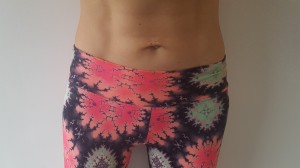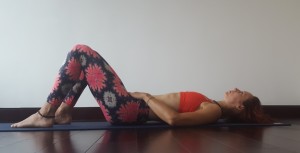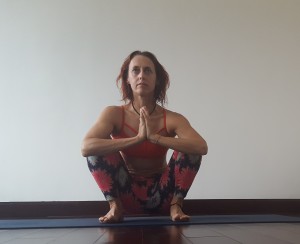In my classes, you will often here me say ‘use your bandhas’. I inherited this from my teacher trainer who was known to yell it across the Mysore Room when he saw someone take on a challenging pose without a sense of these subtle forms. Although there are arguments that they are overused in the modern western yoga practice
Given time, it is my experience that practitioners who use the Bandhas in both their asana and pranayama start to develop a profound understanding of the power of these two practices. Through the containment and control of Prana and Apana, the holistic, energetic and spiritual benefits of the yoga practice are more readily felt and embraced.
Often students do not understand the terms Mūlabandha or Lower/Mini Uḍḍīyāna Bandha and their western representation of pelvic floor and lower abdomen. If they know where they are located, they may not understand how to engage them or what it feels like when they are engaged.
Mini Uḍḍīyāna Bandha/ Uḍḍīyāna Pit
This is sometimes mistakenly called the Uḍḍīyāna Bandha, however, it must be recognized that although there is a similarity in intention between the full expression and the mini expression, they are significantly different. It is often best to develop the full expression before moving on to the more subtle form. The full form is used in advanced pranayama at the retention of the exhale and involves the passive drawing up and back of the abdomen by contracting the muscles used for an inhale. Sometimes referred to as pre-nauli, it is also used to assist students in developing this otherwise complicated kriya (cleansing action). It can be taught without usage in pranayama in order to assist students in understanding the more subtle Mini form.
Sri K Pattabhi Jois describes Mini Uḍḍīyāna Bandha/ Uḍḍīyāna Pit quite simply as ‘lifting the core muscles four inches below the navel’[2]. This simplified description also indicates that teacher assistance is required for development.
In reality, establishing Mini Uḍḍīyāna takes time and constant awareness and attention. It should be practiced during both pranayama and asana to assist in the toning of myofascial structures below the navel. Put in anatomical terms, it requires the contraction or scooping in of the lower transverse abdominis while simultaneously keeping the quadratus lumborum and the psoas released. This allows for a freedom in the back body to develop so that breath can be free and the practitioner feels a sense of expansion. It also allows for the free movement in the diaphragm and the upper abdominal region although care should be taken here not to flare the rib cage as a side effect. The use of the Uḍḍīyāna in this sense then assists in the true development of the Mūlabandha.
Mūlabandha
I am a little partial here to the description from Richard Freeman and Mary Taylor. ‘It is the process of communication across the pelvic floor from side to side and from front to back, and it becomes the platform for an engaged, meditative flow of poses”[3]. Pure poetry but what does it mean in practicality?
The simplest way to guide a student to the Mūlabandha is through the understanding of the lift of the pelvic floor. As Richard argues, this, however, is not the purest form of the Bandha but a means to direct the attention to its positioning. Teachers will often prescribe the squeezing of the anus as a means to connect with the perineum, however, this of itself is Ashwini Mudra and not a representation of the Mūlabandha as per the Ashtganga Vinyasa Method.
Accessing the pelvic floor can be a little of a mystery. We all hear our teachers say it but in reality, what is it?
The pelvic floor has three layers with eleven muscles spread across those layers. Their home is between the tailbone, pubic bone, and the ischial tuberosities (sitbones). They vary in size, density and strength but combined together, are the lower support of the abdominal cavity, assist in respiration and support the spine. By connecting the pubic bone at the front to the tailbone, they are also essential for lower back health. The deeper pelvic floor muscles further assist in this due to their firing connection with the transverse abdominus. As we are built differently in this reproductive region, clearly men and women will feel this differently, however, the point is still the same. The result of the activation of the pelvic floor when used in yoga is a sense of the lifting of the perineum. This lift transmits a sense of energetic elevation throughout the whole body, making it essential for stability in all poses, particularly complex inversions and arm balances.
I have read and often discussed a number of means of engaging this invaluable area. As we all feel things and relate to different descriptions, here are a few suggestions for activating the pelvic floor muscles and subsequently finding a pathway to the Mūlabandha. All should be done with the pelvis in neutral (ie the ASIS (anterior superior iliac spines and the pubic symphysis should be in the same horizontal line) and without activating the muscles of the buttocks, legs or holding the breath
1. For the ladies – inhale and as you exhale, try to lift and tighten the muscles that would usually stop the flow of urine, hold for 10 seconds (best done while lying on your back on the floor with the legs bent to a 45 degree angle)
2. For all practitioners – draw the pubic symphysis to the tailbone while simultaneously feeling the sit bones draw together, then feel these all lift simultaneously (best done while sitting in Virasana or in Malasana)
3. For the fellas – feel as though you are trying to draw your testicles in towards your body
4. For the fellas – place a pair of socks under your perineum as you sit, gently work to lift the perineum off this soft shelf
5. Given time, daily practice, patience and a little bit of application, the tendency to tighten the anal sphincter and the urogenital tract lessens and the practitioner is able to lift the perineum separate from these contractions
A Warning
It is important to note that as with all things in life, too much of something is not a good thing. It is important to find a sense of balance in the usage of the bandhas. Where the engagement is too great for the requirement of a posture, it can actually become restrictive and limit the sense of motion in stillness due to excess rigidity. Where there is excessive strength used in day to day life, constipation can become a side effect. This is where practice, self assessment, daily observation and mindfulness find their way creeping even into this focal point of the asana and pranayama. As every day is different, so too is the engagement that is required and it is this humbling practice that guides us towards the spiritual benefits of concentration and the expansion of awareness.
[1] Eg Leslie Kaminoff, Deshikachar, Ana Forrest[2] Sri K Pattabhi Jois, Yoga Mala (North Point Press) 23.[3] Richard Freeman and Mary Taylor, The Art of Vinyasa (Shambhala Publications Ltd) 21.
http://www.beyondbasicsphysicaltherapy.com/pelvic-floor-anatomy (accessed 04/09/2017) http://www.pilatesdigest.com/the-muscles-of-the-pelvic-floor/ (accessed 04/09/2017)
Feature image courtesy of Time Magazine








